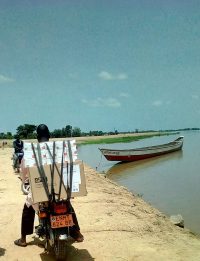
Many roads are inaccessible making deliveries almost impossible for hard to reach areas. Boat transfers of commodities allows for on-site distribution. Photo Credit: Youssoufa Sali – MTA (3PL Company)
What do you get when you provide delivery teams with cheap smartphones with a camera, GPS, and Gmail? A guarantee that one million children are assured life- saving medication.
Seasonal malaria chemoprevention (SMC) is an effective way to control malaria in children but due to many challenges, commodities had not been reaching their destinations in Cameroon. By providing smartphones, different means of transportation, and introducing a geographic information system (GIS) tracking system, the U.S. President’s Malaria Initiative (PMI) has been successful in making sure commodities were delivered to the right place, at the right time, in the right amount, and in the right condition.
Before the GIS tracking system, it was difficult to verify the delivery of the medication. With security challenges and poor road infrastructure being a challenge, bikes, camels, and boats were used in addition to trucks for deliveries to hard to reach areas.
But by employing GIS, Cameroon’s 2018 SMC campaign was able to develop a distribution plan, identify the hard to reach areas, and track deliveries. By working with a third-party company and training staff on required steps to ensure delivery, project staff was able to collect real-time data and confirmation of delivery to 327 health facilities. Within 10 days, 3.4 million treatments for 1 million children between the ages of 3 months to 5 years were dispatched.
Funding and support from PMI, and collaboration with Cameroon’s National Malaria Control Program (NMCP) has allowed for improved visibility and delivery thus creating a significant impact on malaria control and prevention. GIS systems can help improve other public health interventions for hard to reach populations.


